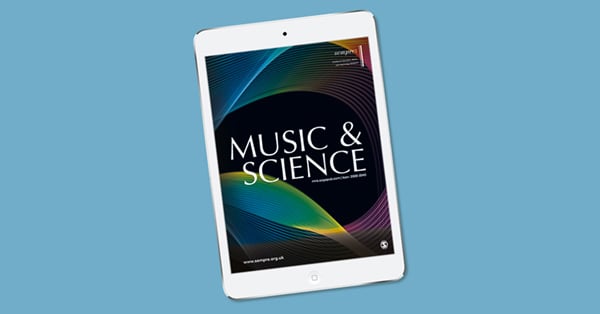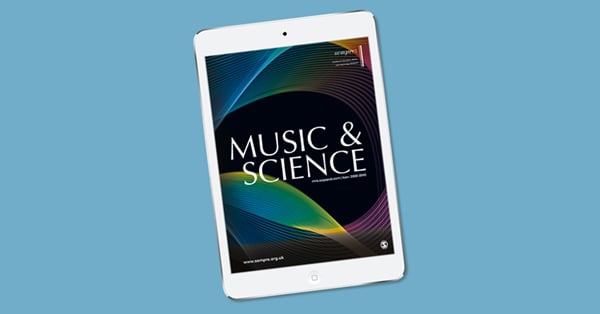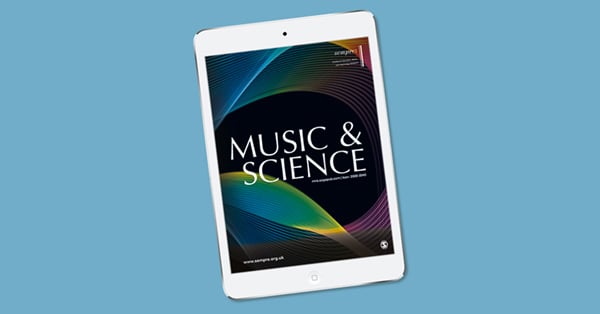
Music & Science
@Music_Science_J
Followers
2K
Following
313
Media
25
Statuses
834
Music & Science, a @sempreorguk #openaccess journal published by @SAGE_News. #musicscience #openscience
Editor Ian Cross
Joined May 2017
“With a Little Help from my Friends”: Exploring Pseudo-Social Music Listening Experiences. New article by Scott Bannister, Freya Bailes + Alinka Greasley. Action Editor: Adam Ockelford. #musicscience #openaccess #OpenScience.
journals.sagepub.com
Contemporary research highlights intimate connections between music and social bonding, such that even modern music listening behaviors, including listening whe...
1
0
2
The Training of Rhythm Skills and Executive Function: A Systematic Review. New article by J. Riikka Ahokas, Suvi Saarikallio, Graham Welch, Usha Goswami + Tiina Parviainen. Action Editor: Ian Cross. #musicscience #openaccess #OpenScience.
journals.sagepub.com
Objective The focus of this study is on rhythm-elicited movement and its impacts on executive function. The main aim of this review was to identify previous, co...
0
2
9
Evaluation of Tone Quality in Piano Performance by Sight and Sound: A Performer's Perspective. New article by Julijana Sarac. Action Editor: Emily Payne. #musicscience #openaccess #OpenScience.
journals.sagepub.com
In the present study, a classically trained pianist aimed to investigate whether the visual cues in her performance influenced observers’ evaluation of her sing...
0
2
5
Seizing the Life of Sounds in Contemporary Instrumental Music: Claude Vivier’s Zipangu (1980), a Spectromorphological Perspective. New article by Mylène Gioffredo. Action Editor: Kai Siedenburg. #musicscience #openaccess #OpenScience.
journals.sagepub.com
This essay has been conceived as an invitation into the workshop of the contemporary music analyst. It aims to familiarize scholars who are interested in but un...
0
1
1
Exploring the Comprehensibility of Ten Different Musical Notation Systems and Underlying Factors. New article by Siyao Cheng, Andrew J. Milne, Roger T. Dean, José Hanham + Jennifer MacRitchie. Action Editor: Isabel Martinez. #musicscience #OpenScience.
journals.sagepub.com
Numerous systems of musical notation have been developed to address some of the complexities associated with conventional Staff notation, such as translating it...
0
1
5
RT @matskussner: And it's a wrap! We’re delighted to announce the publication of our editorial "Music and Mental Imagery" in @Music_Science….
journals.sagepub.com
0
3
0
Musical Reward in Young Children. New article by Haley E. Kragness, Kendra Mehl + Amy M. Belfi. Action Editor: Kelly Jakubowski. #musicscience #openaccess #OpenScience.
journals.sagepub.com
Musical pleasure stems from an interplay of social, emotional, and cognitive factors. In adults, there are large individual differences in musical reward, with ...
0
1
10
Kutanga, Mujimbu, and the Tacit Orchestration of Events Among the Luvale of Zambia. New article by Jason Winikoff. Action Editor: Nina Eidsheim. #musicscience #openaccess #OpenScience.
journals.sagepub.com
Orchestration is an established topic in various music disciplines yet is a rare focus in ethnomusicology. This paper offers a modest remedy by asserting that c...
0
2
3
Audio-Visual Interactions Between Music and the Natural Environment: Self-Reported Assessments and Measures of Facial Expressions. New article by Marek Franěk + Jan Petružálek. Action Editor: Diana Omigie. #musicscience #openaccess #OpenScience.
journals.sagepub.com
The interaction between music and the environment has been widely investigated in various domains; however, the effects of music on the perception of outdoor en...
1
2
6
Body Awareness of the Orofacial Area in Wind and Brass Instrumentalists: An Observational Study. New article by Sarah Lesjak, Lena Ostlangenberg, Harry von Piekartz + Christoff Zalpour. Action Editor: Eckart Altenmüller. #musicscience #openaccess.
journals.sagepub.com
Background Woodwind and brass instrumentalists have a high sensomotoric demand of their orofacial region while playing their instrument. Orofacial problems (OFP...
0
1
4
The Danish Goldsmiths Musical Sophistication Index: Validation in Samples with Different Degrees of Representativeness. New article by Cecilie Møller, @nielschr_, Peter Vuust + Daniel Müllensiefen. Action Editor: Elaine King. #musicscience #openaccess.
journals.sagepub.com
Convenience sampling is often used in music psychology research, leading to an overrepresentation of young participants with high socio-economic status and pote...
0
1
11
Age- and Sex-Related Differences in Music Requests on a Radio Show for Children. New article by Markus von Berg, Anna-Christina Wolf + Jochen Steffens. Action Editor: Alexandra Lamont. #musicscience #openaccess #OpenScience.
journals.sagepub.com
In research on the development of musical preferences, children are often asked either to evaluate musical pieces that have been previously selected by adult ex...
0
1
2
Identifying Peking Opera Roles Through Vocal Timbre: An Acoustical and Conceptual Comparison Between Dan and Laosheng. New article by Annie Y. Liu + Zachary Wallmark. Action Editor: Kai Siedenburg. #musicscience #openaccess #OpenScience.
journals.sagepub.com
Chinese jingju (Peking opera) typically distinguishes several stock character types differentiated by narrative function, appearance, and vocal timbre. Though a...
0
1
6
Sonic Bouquet: Decoding Cross-Modal Correspondences Between Timbre and Scent. New article by Asterios Zacharakis. Action Editor: Zachary Wallmark. #musicscience #openaccess #OpenScience.
journals.sagepub.com
The examination of cross-modal correspondences between auditory and olfactory senses opens up an intriguing perspective into the study of extra-musical meaning....
0
3
5
An Interdisciplinary Timbral Analysis of “ringtone,” by 100 gecs. New article by Lindsey Reymore. Action Editor: Asterios Zacharakis. #musicscience #openaccess #OpenScience.
journals.sagepub.com
In this close analysis of the song “ringtone” by 100 gecs, I unpack the dialectic of noisy and clean timbres, exploring this theme narratively, acoustically, an...
0
2
3
Learning, Understanding, Remembering: The Collective Experiences of Musical Memory of Twelve Professional Classical Guitarists. New article by Thinus Boshoff + Albi Odendaal. Action Editor: Elaine King. #musicscience #openaccess #OpenScience.
journals.sagepub.com
The intention of this basic qualitative study was to investigate the ways in which professional guitarists describe their musical memory, in an attempt to devel...
0
0
4
Categorization of Typical and Atypical Combinations of Excitations and Resonators of Musical Instruments: Assimilation of the Unusual to the Familiar. New article by @erica_huynh + Stephen McAdams. Editor: Asterios Zacharakis. #musicscience #OpenScience.
journals.sagepub.com
Sound categorization is automatic, yet very little is known about how this process works. Physical sound sources such as musical instruments generate sounds tha...
0
1
2
“Beautiful Tone, Beautiful Heart?” Shinichi Suzuki's Pedagogy of Sound and Self. New article by Lindsay J. Wright. Action Editor: Nina Eidsheim. #musicscience #openaccess #OpenScience.
journals.sagepub.com
Among performers and pedagogues of string instruments, “tone” is a term summoned often and valued deeply, yet seldom defined. While many traditional teaching ap...
0
0
1
Motivation in Learning Musical Instruments: The Role of Parents, Teachers, and Friends. New article by Fanni Földi, Norbert Szabó, Tun Zaw Oo, Gábor Csizmadia + Krisztián Józsa. Action Editor: Kelly Jakubowski. #musicscience #openaccess #OpenScience.
journals.sagepub.com
Motivation plays a crucial role in learning, particularly when mastering a musical instrument. However, it remains a relatively unexplored area in Hungarian res...
0
0
6
Neurologically Motivated Simulation of Ensemble Performance. New article by Nima Darabi, U. Peter Svensson + Paul E. C. Mertens. Action Editor: Jessica Grahn. #musicscience #openaccess #OpenScience.
journals.sagepub.com
A “rhythmic agent” is simulated based on the foundation of a previously published behavioral sensorimotor synchronization (SMS) model. The model is adjustable t...
0
0
1




